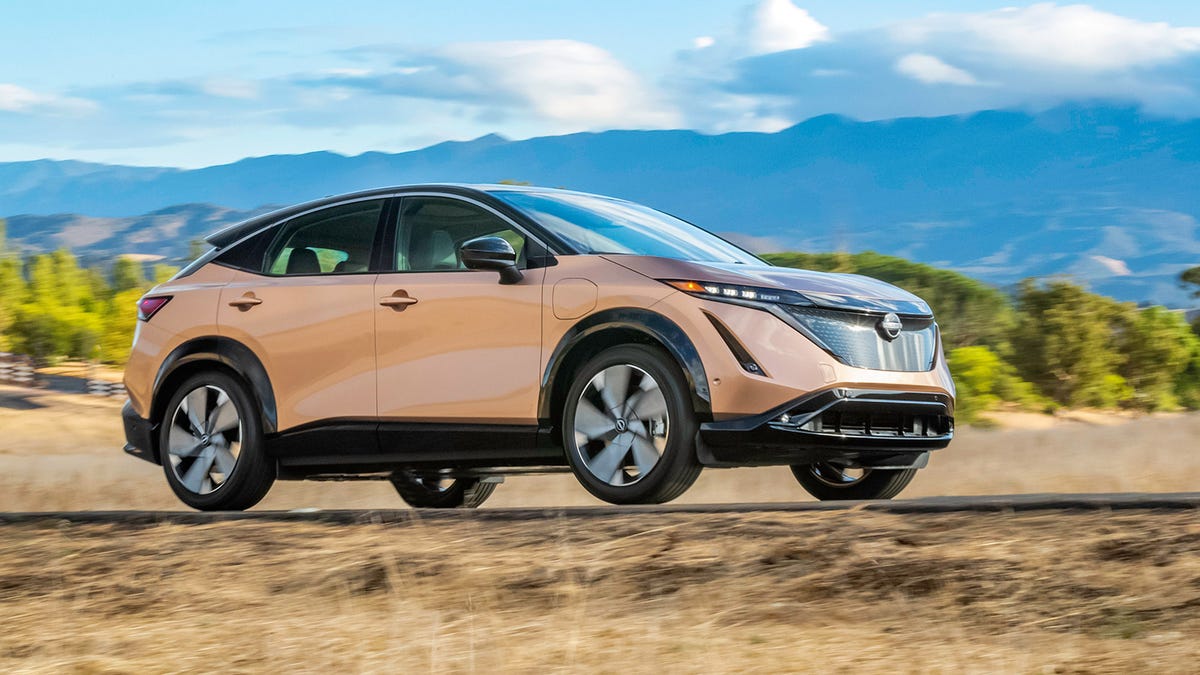Here's How the Top Electric Midsize SUVs Compare in One Handy Roundup

Image: Nissan
This week, Nissan finally announced across-the-board pricing for its upcoming Ariya electric SUV. It’d been a long time coming — the Ariya had been first revealed in 2019, and the Leaf hasn’t exactly been the most popular EV, even if it was one of the first. The brand could use a replacement, and it seems it’ll finally get one.
Everyone Forgot About the Jeep Liberty, Including Jeep
01:08
Danny DeVito Explains Old-School Car Customizing to His Daughter Lucy
2 hours ago
Given the occasion, we thought now would present a good opportunity to compare the various electric, midsize SUVs and crossovers on the market today in terms of pricing and equipment. The segment is heating up and will only continue to in the coming years. There are already so many options out there, and the changing federal tax credit criteria has thrown yet another complexity into deciding on one. Let’s do our best to make sense of it all.
Nissan Ariya — $44,485
Image: Nissan
And let’s start with the Ariya, as it’s the latest to be announced. The cheapest in the range is the front-wheel-drive Engage trim, and can be had for $44,485, including a $1,295 destination charge. It goes all the way up to $61,485 for the range-topping, all-wheel-drive Platinum model. (Technically that one is called the “Platinum+ e-4ORCE.” Hopefully you like your trim levels to double as algebra equations.)
The Engage trims, available in two- or all-wheel drive, have the smaller 63 kWh battery pack, for an estimated range of about 216 miles on a charge. The 87 kWh trims allow you to travel a little further, between 289 and 304 miles.
G/O Media may get a commission

60% off
Jachs NY Fall Sale 60% Off
Styles starting at $29
Layer up with Jachs NY’s fall sale—60% off fall styles. Shirts start at $29, and with the promo code, you can curate a whole layered look.
The low-end FWD packages offer 214 horsepower, but if you opt for an AWD variant, power lifts to 335 or 389 hp. At that point, though, you’re paying at least $55K, with no benefit of a $7,500 federal tax credit, because the Ariya won’t be built in the U.S. At least, not out of the gate.
I do like the look of the Ariya’s interior, and the top-line Platinum spec gets Nappa leather upholstery which is worth highlighting. Those capacitive climate controls on the lower dash look troubling to put it one way, though at least they light up.
The FWD Ariya will be the first to reach dealers in the waning months of this year, while the more sure-footed specs are due in “early 2023.”
Hyundai Ioniq 5 — $41,245
Image: Hyundai
$41,245 gets you into Hyundai’s vaporwave Lancia Delta Integrale, some $3K less than the new Ariya. You do get considerably less power here — just 168 hp, with 220 miles of range. But the Ioniq 5 (and indeed all cars that share its E-GMP underpinnings, like the Kia EV6) can charge really fast, thanks to 800-volt battery architecture that supports peak throughput of 230 kW. Put another way with numbers that everyone will appreciate: going from 10 to 80 percent at a supported fast charger takes this funky hatch merely 18 minutes.
If range is all you care about, you can get into the 303-mile SE with its 225 hp for $45,295. That’s for a single-motor, RWD spec; the dual-motor configuration. Drop at least $48,795 to get into a dual-motor, all-wheel-drive one and distance takes a hit, dropping to 256 miles — though you do get 320 hp. The priciest Ioniq 5, the limited trim with electric motors on each axle, will set you back $55,795. Unfortunately, the days of getting a $7,500 break from the IRS on one of these is over, too.
I don’t love the exterior styling of the Ioniq 5 quite like many seem to, but those who’ve drove it seem be really charmed by the quirky hatch.
Ford Mustang Mach-E — $48,195 Before Credit
Image: Ford
Before we really pick apart the Mustang Mach-E’s pricing, note that it is one of the few cars on this list that still qualifies for the full $7,500 credit, as it’s built in the U.S. Once you take that into consideration, the Mach-E’s base price of $48,195 becomes a little easier to swallow. Of course, it was much easier to swallow prior to the forthcoming 2023 model year, when the cheapest electric pony cost $3,200 less. However, now the Blue Oval can rely on a credit that the majority of its competition no longer gets to cover the price hikes of a supply-throttled industry.
Anyway, with that base Select Mach-E you’re getting a compelling combination of 266 hp sent to the rear wheels and an estimated range of 247 miles. Adding all-wheel-drive to the Select raises the price to $50,895, again pre-credit — though power does not change.
The Mach-E can really get up there though, especially if you’re eyeing the performance-minded GT, with its 480 hp and 600 lb-ft of torque. Then the price balloons to $71,195. There are mid-grade options like the Premium spec that focuses on improving range, and Ford is now giving Select buyers more standard driver-assist tech than they previously got, as my colleague Lawrence explained in his deeper breakdown of 2023 model-year pricing.
Volkswagen ID.4 — $38,790 Before Credit
Image: Volkswagen
The Chattanooga, Tennessee-built Volkswagen ID.4 also still qualifies for the federal credit. And unlike the Mach-E, which sort of needs that credit to stay competitive, the potential $7,500 discount allows the ID.4 to undercut plenty of similarly sized options.
The ID.4 starts at just $38,790, including destination, with 201 hp and a projected 208-mile range. That base trim and its 62 kWh battery is new for 2023; moving up, the 82 kWh pack is still on offer, delivering 275 miles of travel. It costs $43,790. The least-expensive path to dual-motor AWD slides in at $47,590. There are plenty of pricier ID.4 trims as you move up the range, with the Pro variants throwing in leatherette upholstery, a panoramic roof and other luxuries. The most expensive ID.4 — the AWD Pro Plus S — will set you back $55,435.
No, Volkswagen’s electric SUV is not the most stirring on the market. I know plenty of people who were disappointed by it, but I’ll have you know I’ve driven an ID.4 and I found it to be fine — just fine. Yes, even without the frunk. Now that it has a price advantage, I reckon it’s worth a consideration for those looking to get the most bang for their EV buck at the upper $30K/low $40k level.
Toyota bZ4X and Subaru Solterra — $43,335
Image: Subaru
Arguably the weirdest midsize sport utility EVs on this list, the Toyota bZ4X and Subaru Solterra are essentially the same car. For a second, it looked like the big difference would be that Subaru’s version would receive the credit under the old production cap criteria, while Toyota’s wouldn’t. Then the Inflation Reduction Act stepped in to ensure neither will!
Let’s start with the Toyota-badged one. $43,335 gets you 252 miles of range with 201 horsepower sent to the front axle. AWD drops range to 228 miles and adds a whopping 13 hp, for $45,415. The Solterra, in true Subaru fashion, comes with AWD standard and will start at $44,995, pre-destination. It’ll offer 214 hp too, so it seems like Subaru is just lopping off the FWD one that makes getting into the bZ4X cheaper.
Both our Elizabeth Blackstock and Steve DaSilva drove the bZ4X and Solterra, respectively. Their verdicts? A resounding “meh,” irrespectively. Neither appears to match the powertrain of, say, the Mach-E. Nor the tech of the Ioniq 5, or the value of the ID.4. Still, Toyotas and Subarus have a habit of selling so, I think they’ll be just fine.
Kia EV6 — $42,695
Image: Kia
I honestly almost left the Kia EV6 off this list for the simple reason that it does not look like an SUV to me. Sure, “SUV” is a vague descriptor that doesn’t really mean anything anymore, but sometimes you just look at a car and go “that’s not what that is!” Even so, plenty of people cross-shop the EV6 against the rest of this lot, so it deserves a seat at the table. Also because it happens to be really good.
Pricing for the EV6 starts a smidge higher than its platform-mate, the Ioniq 5. It scales up similarly though, with equal powertrain options up and down the range, and most of the differences have to do with slight ride and handling tuning, and perhaps a more rakish greenhouse for the Kia. It’s probably not the better choice for families, then.
There’s a $10K gap between the entry-level, rear-wheel-drive EV6 Light at $42,695, with 167 hp and 237 miles of range, and the cheapest dual-motor option. The latter would be the Wind e-AWD, which ratchets power up to 320 hp and claims 274 miles on a single charge. That one will set you back $52,695; there’s also the more luxurious GT Line and, eventually, the 576-hp GT, which promises 0-60 mph times in the mid-three-second range. Truly an amazing age we live in.
Tesla Model Y — $67,990 Before Credit
Image: Tesla
For funsies, let’s just throw the Model Y in here, as its the only midsize electric SUV a certain subset of shoppers will ever consider. Fun fact: we actually love the Model Y here at Jalopnik, with our old pal Bradley calling it the best “back-and-forth commuter car” for the “vast majority” of American drivers. You’d hope it would be. See, back when Bradley wrote that, the Model Y started just under $50K. Today, MSRP sits at $67,990, including the manufacturer’s $1,200 destination fee. Yikes.
It gets a little better when you account for the potential $7,500 credit, which Teslas now receive again, as the ones Americans can buy are built right here. Both the Model Y Long Range and Performance get at least 300 miles, and both have dual-motor AWD. Tesla doesn’t publish power figures, but the Performance supplies an estimated 480 hp to both axles. Nevertheless, the price makes it a non-starter for all but those eyeing the absolute top of the segment in this roundup.
Verdict
Though the segment for battery-electric midsize SUVs is growing faster than any other, it’s a bit demoralizing how the global economic situation *gestures broadly* has made good values just OK, and rendered decent ones out of contention.
The way I see it, the big winner here is the Volkswagen ID.4, at least until the German automaker’s competitors catch up to manufacturing their EVs in the States as well. If you want the most punch and don’t mind it being the worst-looking car on this list (there, I said it), the Mustang Mach-E remains a very strong package, despite Ford jacking up prices. And of course, the Hyundai/Kia pair remain solid all-around options. Of course, there are also some future products that look mighty enticing; GM is pledging a $30K base for the Equinox EV, when that drops near the end of next year. Watch this space!







